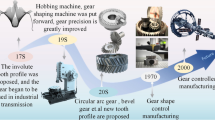Abstract
Planetary gear boxes are suitable for numerous applications due to their compact design and high power density with coaxial in- and output. Especially in wind energy and industrial transmission systems but also in automotive applications such as automatic transmissions, planetary gear drives are commonly used. As a consequence of the continuous increase in the required power, the risk for flank damages has increased recently. Mostly, planetary transmissions are designed as helical gears due to improved NVH behavior and higher pitting resistance acc. to ISO 6336. However, systematic experimental investigations on the flank load carrying capacity of internal helical gears are not known so far.
Based on the theoretical and experimental investigations in the research project FVA 482/II, the existing standardized load carrying capacity calculation method for pitting considering the maximum load could be verified. Thereby, the influence of the helix angle and material pairing of the planet and ring gear on the pitting resistance was studied. Certainly, it is shown that the maximum contact stress is not necessarily located at the pitch point C. Therefore, a detailed analysis of the load distribution and an adapted calculation approach is recommended especially for internal helical gears.
Zusammenfassung
Aufgrund der kompakten Bauweise und hohen Leistungsdichte bei koaxialem An- und Abtrieb kommen Planetengetriebe in zahlreichen Anwendungen zum Einsatz. Besonders in Windkraft- und größeren Industriegetrieben sowie in PKW-Automatgetrieben sind Planetenstufen zu finden. In Folge der zunehmenden Leistungssteigerung in Hochleistungsgetrieben hat sich das Risiko von Flankenschäden in den letzten Jahren erhöht. Häufig werden moderne Planetenradstufen aufgrund des besseren Schwingungsanregungsverhaltens und der höheren Grübchentragfähigkeit nach ISO 6336 schrägverzahnt ausgeführt. Systematische experimentelle Untersuchungen zur Flankentragfähigkeit von Innenschrägverzahnungen sind bisher nicht bekannt. Anhand der theoretischen und experimentellen Arbeiten im Rahmen des Forschungsvorhabens FVA 482/II konnten die bestehenden standardisierten Methoden zur Tragfägkeitsberechnung bestätigt werden. Dabei wurde insbesondere der Einfluss des Schrägungswinkel und der Werkstoffpaarung von Planet und Hohlrad auf die Grübchentragfähigkeit analysiert. Für Hohlräder wird die maßgebliche Flankenpressung zur Tragfähigkeitsberechnung üblicherweise im Wälzpunkt C bestimmt. Die Untersuchungen haben jedoch gezeigt, dass sich für schrägverzahnte Hohlräder abweichend von ISO 6336 die Überprüfung der Pressungsverteilung und gegebenenfalls die Berechnung der Grübchentragfähigkeit mit der maximal auftretenden Flankenpressung empfiehlt.












Similar content being viewed by others
References
ISO 14635-1: Gears—FZG test procedures—Part 1: FZG test method A/8,3/90 for relative scuffing load-carrying capacity of oils (2000)
ISO 6336-2:2006-09: Calculation of load capacity of spur and helical gears—Part 2: Calculation of surface durability (pitting) (2006)
Hein M, Geitner M, Tobie T, Stahl K, Pinnekamp B (2018) Reliability of Gears—Determination of Statistically Validated Material Strength Numbers. AGMA, vol 2018. Fall Technical Meeting (FTM), Chicago
Höhn B‑R, Stahl K, Schudy J, Tobie T, Zornek B (2011) Investigations on the Flank Load Carrying Capacity in the Newly Developed FZG Back-to-Back Test Rig for Internal Gears. AGMA, vol 2011. Fall Technical Meeting (FTM), Cincinnati
Joachim FJ (1984) Investigations on pitting for through-hardened and normalized gears (German: Untersuchungen zur Grübchenbildung an vergüteten und normalisierten Zahnrädern). PhD thesis, TU München
König J, Koller P, Tobie T, Stahl K (2015) Correlation of relevant case properties and the flank load carrying capacity of case-hardened gears. ASME, vol 2015. ASME, Design Engineering Technical Conference, Boston
Matt P, Tobie T (2012) Standardisation of Load Capacity Tests—Recommendations for the Standardisation of Load Capacity Tests on Hardened and Tempered Cylindrical Gears. FVA guideline, FVA 563/I, Forschungsvereinigung Antriebstechnik e. V.
Meusnier JB (1785) Mémoire sur la courbure des surfaces. Mém Des Savans Étrangers 10:477–510
Schudy J: Flank load carrying capacity of internal/external gears (German: Flankentragfähigkeit Innen‑/Außenverzahnung). FVA 482/I, final report 867, Forschungsvereinigung Antriebstechnik e. V. (2008)
Schudy J (2010) Investigations on the flank load carrying capacity of external and internal gears (German: Untersuchungen zur Flankentragfähigkeit von Außen- und Innenverzahnungen). PhD thesis, TU München
Schmidt W (1984) Investigations on the pitting and tooth root load carrying capacity of involute internal spur gears (German: Untersuchungen zur Grübchen- und Zahnfußtragfähigkeit geradverzahnter evolventischer Innenstirnräder). PhD thesis, TU München
Stahl K, Höhn B‑R, Schudy J, Tobie T, Zornek B (2013) Investigations on the Flank Load Carrying Capacity of Internal Gears. International Conference on Gears. Ingenieure, vol 2013. VDI – Verein Deutscher, München
Zornek B, Tobie T, Stahl K: Flank load carrying capacity of internal spur and helical gears (German: Flankentragfähigkeit Innenverzahnung). BMWi/AiF 16353-N, FVA 482/II, final report 1086, Forschungsvereinigung Antriebstechnik e. V. (2014)
Zornek B (2018) Investigations on the flank load carrying capacity of through-hardened and nitrided external and internal gears (German: Untersuchungen zur Flankentragfähigkeit vergüteter und nitrierter Innen- und Außenverzahnungen). PhD thesis, TU München
Funding
This research project 16353-N (FVA 482/II) was sponsored by the Arbeitsgemeinschaft industrieller Forschungsvereinigungen e. V. (AiF) by funds of the Bundesministerium für Wirtschaft (BMWi) with an equity ratio by the Forschungsvereinigung Antriebstechnik (FVA).
Author information
Authors and Affiliations
Corresponding author
Rights and permissions
About this article
Cite this article
Geitner, M., Zornek, B., Tobie, T. et al. Investigations on the pitting load capacity of internal spur and helical gears. Forsch Ingenieurwes 83, 553–561 (2019). https://doi.org/10.1007/s10010-019-00327-8
Received:
Revised:
Accepted:
Published:
Issue Date:
DOI: https://doi.org/10.1007/s10010-019-00327-8




